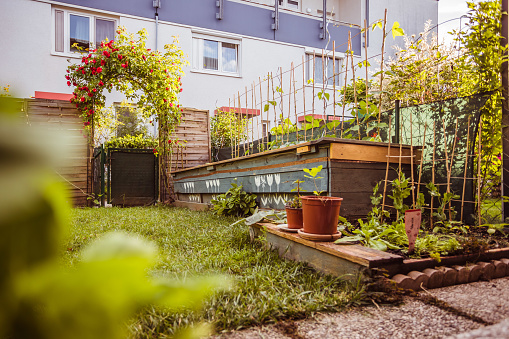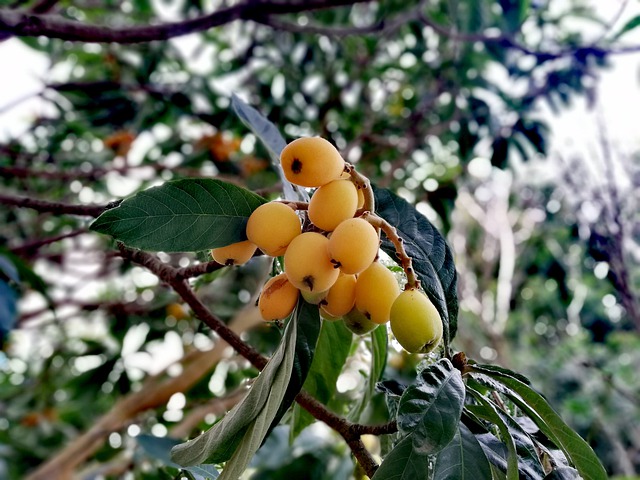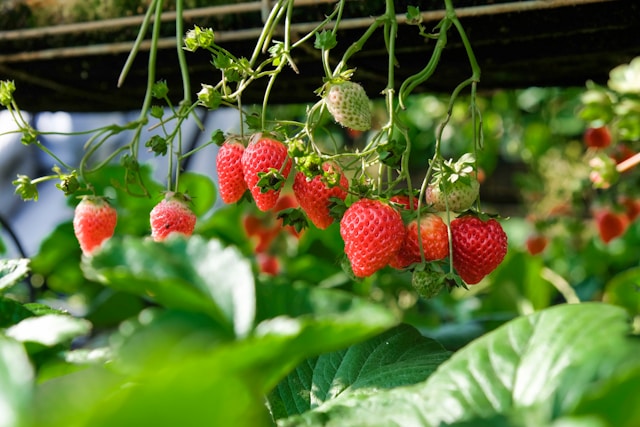How to Grow Blueberry Plants in Pots
[et_pb_section fb_built=”1″ _builder_version=”4.8.1″ _module_preset=”default”][et_pb_row _builder_version=”4.8.1″ _module_preset=”default” custom_padding=”1px|||||”][et_pb_column type=”4_4″ _builder_version=”4.8.1″ _module_preset=”default”][et_pb_text admin_label=”Introduction” _builder_version=”4.8.1″ _module_preset=”default”]
Updated 22 January 2025
Its time to find out how to grow blueberry plants in pots!
Why?
Because blueberries are a superfood packed with antioxidants and many other beneficial nutrients that are so good for you!
You only need to eat one cup of blueberries a day to get 24% of the recommended daily allowance of vitamin C.
So, it makes sense to grow your own, and you can just pick them fresh and insecticide free, off your bushes.
[/et_pb_text][/et_pb_column][/et_pb_row][et_pb_row column_structure=”2_5,3_5″ _builder_version=”4.8.1″ _module_preset=”default” min_height=”516.4px” custom_padding=”1px||0px|||”][et_pb_column type=”2_5″ _builder_version=”4.8.1″ _module_preset=”default”][et_pb_image src=”https://www.urban-gardener.co.za/wp-content/uploads/2022/07/Pinterest-how-to-grow-a-blueberry-bush1.png” alt=”Pinterest pin showing how to grow a blueberry bush in a container” title_text=”Pinterest – how to grow brussel sprouts in a pot” admin_label=”Pinterest Pin” _builder_version=”4.8.1″ _module_preset=”default”][/et_pb_image][/et_pb_column][et_pb_column type=”3_5″ _builder_version=”4.8.1″ _module_preset=”default”][et_pb_text _builder_version=”4.8.1″ _module_preset=”default”]
During spring, the plant blossoms out with tiny, white flowers which turn into blue summer berries so these are really pretty plants to have growing on your deck or balcony.
Blueberries form in clusters but ripen at different times. A few days after the berries turn a deep blue color, you can hand-pick them and they’ll come off the bushes very easily.
Note: if you are on blood thinners, consult with your doctor before increasing your blueberry intake. They are high in vitamin K which can have an effect on blood thinning.
Even if you are homesteading from your apartment, you can also join in the fun and start growing your own blueberry plants in pots right on your balcony.
[/et_pb_text][/et_pb_column][/et_pb_row][et_pb_row _builder_version=”4.8.1″ _module_preset=”default” custom_padding=”0px|||||”][et_pb_column type=”4_4″ _builder_version=”4.8.1″ _module_preset=”default”][et_pb_text admin_label=”H2 – Suitable Containers for Blueberry Plants” _builder_version=”4.8.1″ _module_preset=”default”]
Suitable Containers for Blueberry Plants
[/et_pb_text][et_pb_text _builder_version=”4.8.1″ _module_preset=”default” custom_margin=”||36px|||”]
CONTAINER: At least 45cm/ 18 inches. Choose a nice large pot so there is space for the roots to grow
MATERIAL: Any non-porous material
SITE: They can grow in partial shade but do better in full sun
[/et_pb_text][et_pb_text admin_label=”H2 – Common Varieties of Blueberry Plants” _builder_version=”4.8.1″ _module_preset=”default”]
Common Varieties of Blueberry Plants
[/et_pb_text][et_pb_text _builder_version=”4.8.1″ _module_preset=”default” min_height=”247.4px”]
Generally speaking, you get two main types of blueberry plants; early-season plants and late-season plants, and these will produce berries, yes in the early part of the season, or the late part of the season.
There are four most common types:
* Rabbiteye
* Hybrid Half-high
* Lowbush
* Highbush
The Highbush variety is the most frequently grown type of blueberry plant.
[/et_pb_text][et_pb_text admin_label=”H2 – Starting Off Growing Your Blueberry Plants” _builder_version=”4.8.1″ _module_preset=”default”]
Starting Off Growing Your Blueberry Plants
[/et_pb_text][et_pb_text _builder_version=”4.8.1″ _module_preset=”default” custom_margin=”||35px|||”]
The best way to begin is to buy a young blueberry plant or even one that already has fruits or flowers.
Some people would see this as çheating, but if it works for you, then go for it!
If you do decide to grow them from seed and you are successful, you’re going to wait anything from two to four years before you’re able to add these pops of blueness into your smoothie.
Plant two or more blueberry plants together, or in two pots close to one another (no more than 1 metre/ 3 foot apart), and you’ll find that your fruit will get better year after year.
During the planning phase, also consider growing companion plants with your blueberry plants. This is an easy organic way to naturally deter pests, weeds and protect your plants.
[/et_pb_text][et_pb_text admin_label=”H2 – Preparing the Soil for Your Blueberry Plants” _builder_version=”4.8.1″ _module_preset=”default”]
Preparing the Soil for Your Blueberry Plants
[/et_pb_text][et_pb_text _builder_version=”4.8.1″ _module_preset=”default” custom_margin=”||34px|||”]
Blueberry plants are acid-loving plants. One of the reasons is because they are rich in zinc and iron.
You can buy acid (ericaceous) soil or you can create soil with the correct pH levels yourself. When growing your blueberry plants in pots, mix this ericaceous soil with peat – this will help them grow best and assist with drainage.
Test the pH level of the soil and if it is still too alkaline, add elemental sulfur that you can pick up from your garden center, and mix it into the top six to eight inches of soil around the stem of your plant.
It will take a couple of months for the soil to reach the correct pH levels, so if you are planning to do it this way, prep the soil in the fall so that it’s ready for your plants in the spring.
Fill the pot leaving 5cm/ 1 inch from the top for water.
Make a hole in the soil large enough for your new plant, carefully place the plant into the hole, fill with more compost/ soil mix and press it down so your new blueberry plant stands firmly.
Once it is in, give it a good watering.
[/et_pb_text][et_pb_text admin_label=”H2 – Help Your Blueberry Plants Mature Faster” _builder_version=”4.8.1″ _module_preset=”default”]
Help Your Blueberry Plants Mature Faster
[/et_pb_text][et_pb_text _builder_version=”4.8.1″ _module_preset=”default”]
If your plants are still very young, or you’ve grown them yourself from seed, snip off the first flowers.
Pinching off the first two or three white flowers, and continuing to do this for two or three months, will encourage your plant to focus on root growth and development, as well as producing healthy foliage.
If the roots and leaves and branches are strong and healthy, the bush will mature faster and start producing fruits.
[/et_pb_text][et_pb_image src=”https://www.urban-gardener.co.za/wp-content/uploads/2022/06/blueberry.jpg” alt=”white blueberry flowers” admin_label=”Image – white blueberry flowers” _builder_version=”4.8.1″ _module_preset=”default” custom_margin=”||35px|||”][/et_pb_image][et_pb_text admin_label=”H2 – Mulching Your Blueberry Plants” _builder_version=”4.8.1″ _module_preset=”default”]
Mulching Your Blueberry Plants
[/et_pb_text][et_pb_text _builder_version=”4.8.1″ _module_preset=”default” custom_margin=”||35px|||”]
Homemade mulch options are much better for your plants, and ultimately for you.
Acidic soil plants love being mulched with bark or pine needles. Fill this around the top of your plant.
Bark and pine needles are fairly acidic and will help the soil naturally.
Doing this also prevents the stem from becoming too wet when you’re watering your plants.
[/et_pb_text][et_pb_text admin_label=”H2 – Feeding Your Blueberry Plants” _builder_version=”4.8.1″ _module_preset=”default”]
Feeding Your Blueberry Plants
[/et_pb_text][et_pb_text _builder_version=”4.8.1″ _module_preset=”default” custom_margin=”||36px|||”]
During the growth phase, feed them fortnightly with a balanced feed formulated for acid-loving plants.
[/et_pb_text][et_pb_text admin_label=”H2 – Watering Your Blueberry Plants” _builder_version=”4.8.1″ _module_preset=”default”]
Watering Your Blueberry Plants
[/et_pb_text][et_pb_image alt=”how to grow brussel sprouts” title_text=”Urban Gardener – brussel sprouts 2″ align=”center” admin_label=”image – add an image” _builder_version=”4.8.1″ _module_preset=”default”][/et_pb_image][et_pb_text _builder_version=”4.8.1″ _module_preset=”default” custom_margin=”||35px|||”]
Stay green by using rain water in your gardening and use this to water your blueberry plant.
Tap water will make the soil less acidic, but if that’s all you’ve got then just remember to keep testing the pH levels of the soil.
When you water your plants, moisten the soil up to 6 inches from the stem.
Either stick your finger into the soil to feel the moisture, or use the moisture reader..
Water your plants often from spring to autumn, and then slow down during the winter period.
[/et_pb_text][et_pb_text admin_label=”H2 – Cover Your Plants with Netting” _builder_version=”4.8.1″ _module_preset=”default”]
Cover Your Plants with Netting
[/et_pb_text][et_pb_text _builder_version=”4.8.1″ _module_preset=”default” custom_margin=”||36px|||”]
It’s not only humans who love these berries – birds and other creatures love blueberries too! When your plant starts to produce berries, cover it with netting to keep the birds and animals away.
[/et_pb_text][et_pb_image src=”https://www.urban-gardener.co.za/wp-content/uploads/2022/07/Best-companion-plants-for-blueberry-bushes.png” alt=”A banner sign that reads the best companion plants for blueberries” title_text=”Urban Gardener – brussel sprouts 2″ url=”https://www.urban-gardener.co.za/best-companion-plants-for-blueberry-bushes.html” url_new_window=”on” align=”center” admin_label=”Banner – best companion plants for blueberry bushes” _builder_version=”4.8.1″ _module_preset=”default”][/et_pb_image][et_pb_text admin_label=”H2 – Pruning Your Blueberry Plants” _builder_version=”4.8.1″ _module_preset=”default”]
Pruning Your Blueberry Plants
[/et_pb_text][et_pb_text _builder_version=”4.8.1″ _module_preset=”default”]
Plants over three years old should be pruned annually at winter time.
Try these pruning tips for your fruit bushes.
When pruning your plant, use clean shears and remove the top one-third of the branches, as well as any dead or unproductive branches.
Doing this will make room for younger branches and will ensure better growth and fruit production when the weather starts to get warmer.
[/et_pb_text][et_pb_text admin_label=”H2 – Summary” _builder_version=”4.8.1″ _module_preset=”default” custom_margin=”34px|||||” hover_enabled=”0″ sticky_enabled=”0″]
Final Word…
[/et_pb_text][et_pb_text _builder_version=”4.8.1″ _module_preset=”default”]
Blueberry plants can be finicky but follow the instructions and most importantly, get the pH levels of the soil right, and don’t forget to feed it.
If you buy a plant from your garden center, ask for some advice if you need, place it in a sheltered area in the sun, and pretty soon you’ll have gorgeous little fairy-like bell flowers turning into really tasty blueberries for you to snack on.
Follow me for more container gardening tips!
[/et_pb_text][/et_pb_column][/et_pb_row][/et_pb_section]






